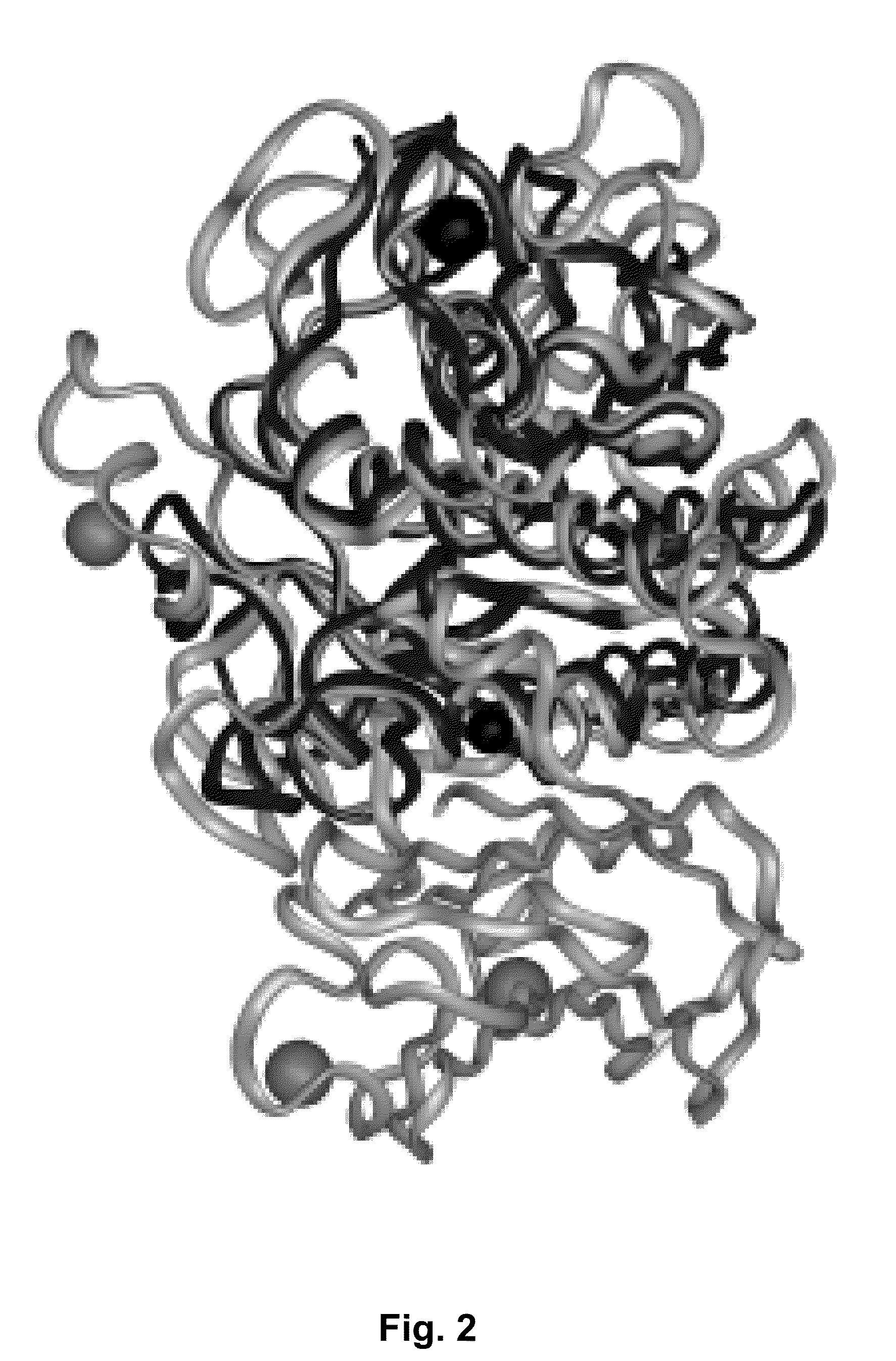Subtilases
a technology of subtilases and bpn, which is applied in the field of jp170 and bpn ′ like subtilases, can solve problems such as incorrect three-dimensional model structure, and achieve the effects of improving thermostability, reducing ph, and increasing activity
- Summary
- Abstract
- Description
- Claims
- Application Information
AI Technical Summary
Benefits of technology
Problems solved by technology
Method used
Image
Examples
example 1
Removal of Ion-binding Sites from BPN′ Like Subtilases
[0376]The below mentioned regions in JP170 and TY145 have been selected for transfer from JP170 and TY145 to Savinase. By use of the molecular methods of preparing subtilase variants as described herein, the Savinase regions (BPN′ numbering) are deleted and the JP170 and TY145 regions are inserted instead. Since the Savinase regions are in contact with ion-binding sites, the purpose of the modifications is to remove the ion-binding site from Savinase.
Savinase region A194-L196 (SEQ ID NO: 8)
JP170 region P209-P217 (SEQ ID NO: 1) and
Savinase region L75-L82 (SEQ ID NO: 8)
TY145 region H83-Y92 (SEQ ID NO: 7),
alternatively the modification can be
Savinase region A194-L196 (SEQ ID NO: 8)
JP170 region P209-P217 (SEQ ID NO: 1) and
Savinase region L75-L82 (SEQ ID NO: 8)
JP170 region N79-K83 (SEQ ID NO: 1).
[0377]Construction and Expression of Enzyme Variants:
Site-directed Mutagenesis:
[0378]Subtilase JP170 site-directed variants of the invention ...
example 2
Purification and Assessment of Enzyme Concentration
[0385]After fermentation, purification of subtilisin variants is accomplished using Hydrophobic Charge Induction Chromatography (HClC) and subsequent vacuum filtration. To capture the enzyme, the HClC uses a cellulose matrix to which 4-Mercapto-Ethyl-Pyridine (4-MEP) is bound.
[0386]Beads of the cellulose matrix sized 80-100 μm are mixed with a media containing yeast and the transformed B. subtilis capable of secreting the subtilisin variants and incubated at pH 9.5 in Unifilter® microplates.
[0387]As 4-MEP is hydrophobic at pH>7 and the subtilisin variants are hydrophobic at pH 9.5 a hydrophobic association is made between the secreted enzyme and the 4-MEP on the beads. After incubation the media and cell debris is removed by vacuum filtration while the beads and enzyme are kept on the filter.
[0388]To elute the enzyme from the beads the pH is now lowered by washing the filter with an elution buffer (pH 5). Hereby the enzymes part fro...
example 3
Automatic Mechanical Stress Assay (AMSA)
Description of AMSA-test Method:
[0392]Washing experiments are performed in order to assess the wash performance of selected JP170 subtilase variants in detergent compositions. Subtilases of the present application were tested using the Automatic Mechanical Stress Assay (AMSA). With the AMSA, the wash performance of a large quantity of small volume enzyme-detergent solutions can be examined. The AMSA plate has a number of slots for test solutions and a lid firmly squeezing the textile swatch to be washed against all the slot openings. During the washing time, the plate, test solutions, textile and lid are vigorously shaken to bring the test solution in contact with the textile and apply mechanical stress in a regular, periodic oscillating manner. For further description see WO 02 / 42740 especially the paragraph “Special method embodiments” at page 23-24.
[0393]The experiment was conducted under the experimental conditions specified below:
Commerci...
PUM
| Property | Measurement | Unit |
|---|---|---|
| concentration | aaaaa | aaaaa |
| concentration | aaaaa | aaaaa |
| angles | aaaaa | aaaaa |
Abstract
Description
Claims
Application Information
 Login to View More
Login to View More - R&D
- Intellectual Property
- Life Sciences
- Materials
- Tech Scout
- Unparalleled Data Quality
- Higher Quality Content
- 60% Fewer Hallucinations
Browse by: Latest US Patents, China's latest patents, Technical Efficacy Thesaurus, Application Domain, Technology Topic, Popular Technical Reports.
© 2025 PatSnap. All rights reserved.Legal|Privacy policy|Modern Slavery Act Transparency Statement|Sitemap|About US| Contact US: help@patsnap.com



